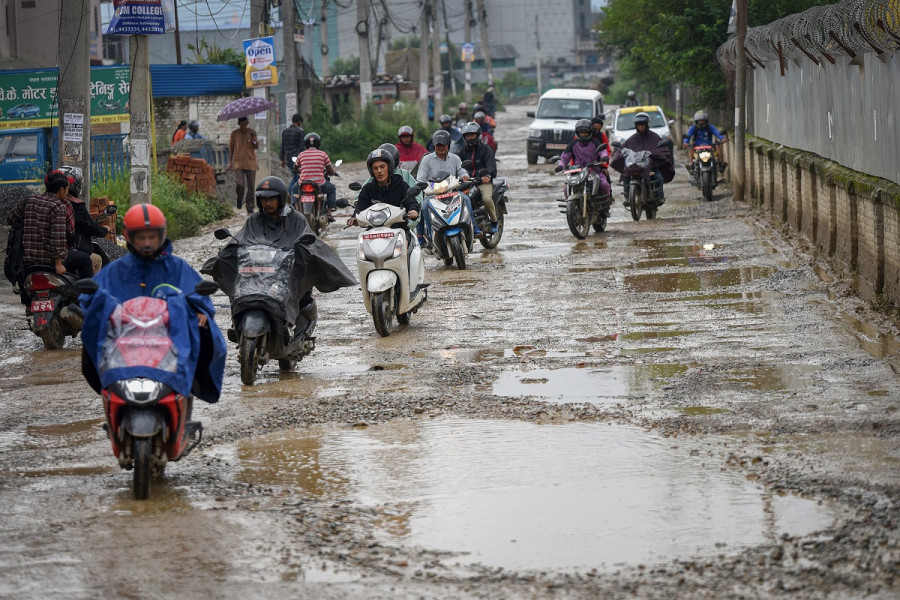Valley
Poor roads continue to trouble Kathmandu denizens; authorities say they could not work because of lockdown
The Department of Roads had announced to upgrade the Valley’s roads during the lockdown, but its work was focused mostly on the so-called VIP areas.
Anup Ojha
Thirty-three-year-old Som Rana from Samakhushi in Kathmandu cycles to his office in Dillibazaar every morning. Rana, an urban designer and also the vice president of the Nepal Cycle Society, says he does not feel safe cycling through the Valley’s roads, which are filled with potholes and coated with mud during monsoon.
“It’s been five years since I started cycling to my office in Dillibazaar. Nothing has changed over the years. The roads are still in a poor state and filled with potholes, posing a risk to all two wheelers, four wheelers and pedestrians alike,” said Rana.
Poor condition of roads and unmanaged drainage have made life difficult for many. Every year, with the onset of monsoon, the Valley sees many of its roads turn muddy and potholes filled with mud water. When it does not rain, the roads get covered with dust.
“Whenever it rains, the drainage leaks and the whole area in Chuchepati gets waterlogged. It’s been years since we started facing this problem but the concerned authorities have done nothing,”said Hema Tamang, a furniture shop owner in Chuchepati.
In the Jayanti Nagar area along the Balkhu River corridor, the incessant rains this past week have filled the roads with knee-deep mud.
“The roads are so muddy that it reaches upto your knees when you walk through them,” said Amrit Bhatta, a retail shop owner in the area. “Earlier, I had to close my shop due to the lockdown. Now, customers don’t come to my shop because of the muddy roads.”
Although the Department of Roads had announced that it would be utilising the lockdown period to upgrade the Valley’s roads, it has not done much. The Department’s data shows that only 12 kilometres of road sections in VIP areas like Singhadurbar, Bhadrakali, Ratnapark, Tripureshwor, Teku, Maharajgung, Baluwatar, Babarmahal and New Baneshwor were asphalted during the period.
Shiva Hari Sapkota, spokesperson for the Department of Roads, says the department could not upgrade the roads in other areas of the Valley due to a shortage of manpower during the lockdown.
“We will carry out the repair works in other parts of the Valley once the monsoon is over,” said Sapkota.
Meanwhile, the Kathmandu Metropolitan City, which is responsible for repairing and upgrading the inner roads, has not done much work during the lockdown period.
Ishwor Man Dangol, spokesperson for the city, said the city had allocated Rs 50 million for road upgradation in the last fiscal year, but only two million was spent because of the lockdown.
When Mayor Bidya Sundar Shakya was elected the city's chief in 2017, his priority was to repair the roads of Kathmandu. However, every monsoon, Kathmandu denizens continue to suffer from unrepaired roads, poor drainage system and uncovered manholes.
Meanwhile, Deputy Mayor Hari Prabha Khadgi blames the present state of roads on the lockdown. “The city office has allocated budgets to all 32 wards but no roads could be upgraded due to the nationwide lockdown,” said Khadgi. “The onus lies on the public too; they never complain regarding the poor state of the roads in their area.”
However, Rana from Samakhushi said it's an irony that elected leaders are coming up with such excuses. “They were elected by people to serve people. This is a lame excuse. There have been numerous complaints in the ward offices but they never work for the public,” said Rana.



 6°C Kathmandu
6°C Kathmandu.jpg)










